Green Lantern/Green Arrow
 Hard-Traveling Heroes, Then and Now
Hard-Traveling Heroes, Then and Now
A look at the original and recent “Green Teams”
 Green Lantern #76-89 (collected in two “Hard-Traveling Heroes” TPBs)
Green Lantern #76-89 (collected in two “Hard-Traveling Heroes” TPBs)written by Dennis O’Neil, pencils by Neal Adams
Comics historians like to point to certain “key” creators or creations, examples that changed the way the medium was looked at or the stories it told. Outcault’s The Yellow Kid, Siegel & Shuster’s Superman, Lee & Kirby’s X-Men, Crumb’s Zap, Miller’s The Dark Knight Returns, Spiegelman’s Maus. Another of these landmarks (though not quite of the magnitude of some of the preceding examples) is O’Neil & Adams’ Green Lantern / Green Arrow.
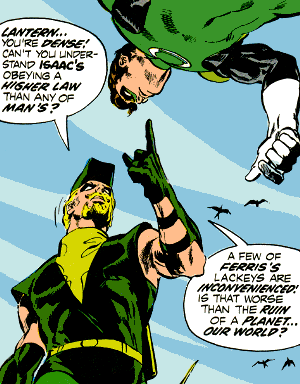 In the early 70’s, American society was going through an upheaval of sorts. Everything from dress codes to draft cards was being challenged. Things that had been taken for granted for generations were being undermined… and whether it was for good or bad was a hotly debated matter of opinion. And in the pages of Green Lantern magazine (”co-starring Green Arrow”), this open disagreement was given form in the characters of Hal Jordan and Oliver Queen.
In the early 70’s, American society was going through an upheaval of sorts. Everything from dress codes to draft cards was being challenged. Things that had been taken for granted for generations were being undermined… and whether it was for good or bad was a hotly debated matter of opinion. And in the pages of Green Lantern magazine (”co-starring Green Arrow”), this open disagreement was given form in the characters of Hal Jordan and Oliver Queen.
Hal was the fearless and noble test pilot who wielded the amazing power ring of the Green Lanterns… a conservative, establishment “cop”. Ollie was the bearded rogue who shared both the political attitude and bow-and-arrow skills of Robin Hood… a liberal, evolutionary “hippie”. But despite their differences, both were heroes… and they were friends.
Denny O’Neil introduced some rather “touchy” subjects during his two years writing the series: environmental damage (featuring a rather Christ-like eco-terrorist hippie), racism (including Hal Jordan’s), exploitation of Native Americans, poverty (rural and urban), over-population, and drug use. This last item was almost certainly the most shocking, because they didn’t just show GL and GA busting up some slimeball drug pushers (which would have been ground-breaking for it’s day). They went further, and revealed that Ollie’s ward Roy (a.k.a Green Arrow’s sidekick “Speedy”) was a heroin addict (or as Ollie puts it - in a moment of rage - “a lousy junkie”).
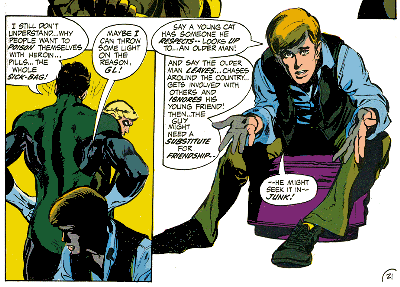 OK, so the language - especially the dialog - was a bit over-the-top and tried a bit too hard to be “hip”. As a result, it’s rather dated. But as O’Neil admits, he was writing material he expected to be thrown away, not saved, collected, and reprinted decades later. And the point of his approach to the series was to make it specifically relevant to the time period; making it noticeably “now” for the early 70’s makes it equally noticeably “then” reading it today. The stories themselves stand up pretty well, however. O’Neil’s ability to tell a complete story in a single issue (usually) while gradually carrying forward sub-plots (e.g. Hal’s romance with Carol Ferris, the cross-country road trip with the Guardian) and bits of “continuity” (e.g. Ollie’s arm injury, Hal’s reduced power level) might seem out of place today, when self-contained stories are the exception, and those sub-plots are expected to be the story. But these tales could still be rescripted (with some fashion “corrections” to the art) and released today and work fairly well.
OK, so the language - especially the dialog - was a bit over-the-top and tried a bit too hard to be “hip”. As a result, it’s rather dated. But as O’Neil admits, he was writing material he expected to be thrown away, not saved, collected, and reprinted decades later. And the point of his approach to the series was to make it specifically relevant to the time period; making it noticeably “now” for the early 70’s makes it equally noticeably “then” reading it today. The stories themselves stand up pretty well, however. O’Neil’s ability to tell a complete story in a single issue (usually) while gradually carrying forward sub-plots (e.g. Hal’s romance with Carol Ferris, the cross-country road trip with the Guardian) and bits of “continuity” (e.g. Ollie’s arm injury, Hal’s reduced power level) might seem out of place today, when self-contained stories are the exception, and those sub-plots are expected to be the story. But these tales could still be rescripted (with some fashion “corrections” to the art) and released today and work fairly well.
I’d hate to see the art messed with, however, because it was really first rate. Neal Adams’ style “makes” these stories as much as O’Neil’s scripts. I don’t have a lot of comics from this time period, but his use of unusual, continually-changing page layouts and perspectives seems very innovative, especially for its time. His figures are almost always realistically human (except when they’re not human, of course), and consistently and instantly recognisable. The faces are expressive, and it’s easy to tell - even in the more experimental panels - what’s going on.
The O’Neil/Adams GL/GA didn’t last very long: only a dozen bi-montly issues. But it gave us a lot. It ushered in new attitude about dealing with “serious” subjects in comics… without which such later landmarks as Watchmen and The Dark Knight Returns, and such trends as major-press “mature readers” comics might not have happened. It gave Ollie and Hal (and Black Canary and Speedy) much-needed characterisation and depth. It introduced characters like John Stewart (a black architect chosen to be Hal’s backup) and the Old-Timer (a Guardian who came to Earth and gave up his immortality). It gave us developments like Hal unmasking for Carol, and Ollie taking refuge at a monastery after accidentally killing. It gave us stories and art that are still remembered, referred to, and respected, more than a quarter century later….
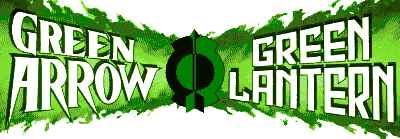 Green Lantern vol.2 #76-77, Green Arrow #110-111
Green Lantern vol.2 #76-77, Green Arrow #110-111
written by Chuck Dixon and Ron Marz
pencils by Rodolfo Damaggio and Paul Pelletier
Apparently someone at DC remembered that Green Lantern vol.1 #76 was the issue in which Hal Jordan and Oliver Queen began their regular team-ups, and decided to do a tribute to that when Green Lantern vol.2 #76 rolled around. Of course Ollie and Hal are both out of the picture now; the new Green Arrow is Ollie’s (illegitimate) son and protégé Connor Hawke, and the only Green Lantern left is Kyle Rayner, a rookie who got the power ring by being in the right place at the right time. So this “reunion” features them instead. Another difference is that Green Arrow has his own series now, so they got to meet first in Green Arrow #104, and the follow-up “reunion” story several months later crossed over between their two monthly series, for two issues each.
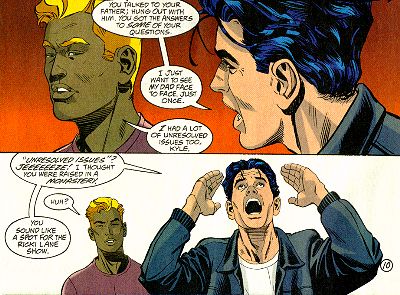 But just like Kyle Rayner is no Hal Jordan, writers Chuck Dixon and Ron Marz are no Denny O’Neil. This “next generation” story lacks the relevance and power of the classic GL/GA tales. Instead of hard-hitting debates about the environment, drugs, or racism, we start off with gags about America’s obsession with law suits. Instead of tense conflict between Hal’s might-for-right law-and-order attitude and Ollie’s man-on-the-street idealism, we get Kyle making an ass of himself over his libido and Connor being embarrassed. Instead of “My ward Speedy is… a junkie!” we get “Connor, if you’re trying to say you’re gay, that’s cool…”/”No, it’s not that.” You know you’re in trouble when Green Lantern is spouting apathetic 90’s tolerance and sweeping any real issues under the rug. And when the threat they face turns out to be a maniac bent on destroying Washington DC to “make America proud again”, it’s not exactly the sort of story that “makes you think”.
But just like Kyle Rayner is no Hal Jordan, writers Chuck Dixon and Ron Marz are no Denny O’Neil. This “next generation” story lacks the relevance and power of the classic GL/GA tales. Instead of hard-hitting debates about the environment, drugs, or racism, we start off with gags about America’s obsession with law suits. Instead of tense conflict between Hal’s might-for-right law-and-order attitude and Ollie’s man-on-the-street idealism, we get Kyle making an ass of himself over his libido and Connor being embarrassed. Instead of “My ward Speedy is… a junkie!” we get “Connor, if you’re trying to say you’re gay, that’s cool…”/”No, it’s not that.” You know you’re in trouble when Green Lantern is spouting apathetic 90’s tolerance and sweeping any real issues under the rug. And when the threat they face turns out to be a maniac bent on destroying Washington DC to “make America proud again”, it’s not exactly the sort of story that “makes you think”.
I’m being a bit harsh, I suppose. The story at least brings up a few points of disagreement before skewing everything off into a pat superheroic ending. O’Neil did that a bit as well, sometimes using Hal as a foil to show how Ollie was right all along. And in many ways, the subtlety of the modern stories works better than the heavy-handed moralising of the classic tales. But that subtlety makes it all the more obvious when Marz and Dixon go for a simplistic beat-em-up resolution.
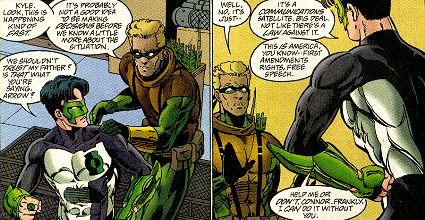 The art in the modern books compares more favourably than the writing. Both Rodolfo DaMaggio and Paul Pelletier show some of Neal Adams’ influence on the comics art form… frequently using page layouts that defy the traditional “grid” structure (and my ability to include them in this review {grin}). DaMaggio’s figures are beautifully subtle and detailed (more so than Adams’, which - to be fair - were drawn for a coarser grade of paper and printing process). Pelletier’s tend to be a bit more stiff and “posed”, but are still pretty good.
The art in the modern books compares more favourably than the writing. Both Rodolfo DaMaggio and Paul Pelletier show some of Neal Adams’ influence on the comics art form… frequently using page layouts that defy the traditional “grid” structure (and my ability to include them in this review {grin}). DaMaggio’s figures are beautifully subtle and detailed (more so than Adams’, which - to be fair - were drawn for a coarser grade of paper and printing process). Pelletier’s tend to be a bit more stiff and “posed”, but are still pretty good.
It’s nice to see that Dixon and Marz have enough respect for the classic team-up stories of O’Neil’s day to pay homage to them with this cross-over between their series (and another due in a couple months, when Green Arrow reaches the “landmark” #125). But there’s something about this story that screams “this is not your father’s GL/GA”… and you know, it’s not.
Too bad.
